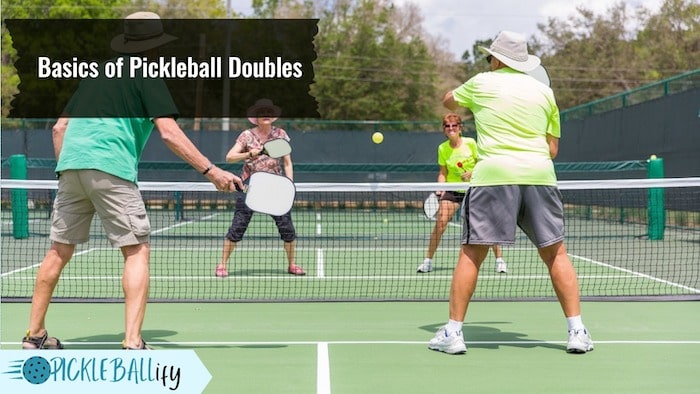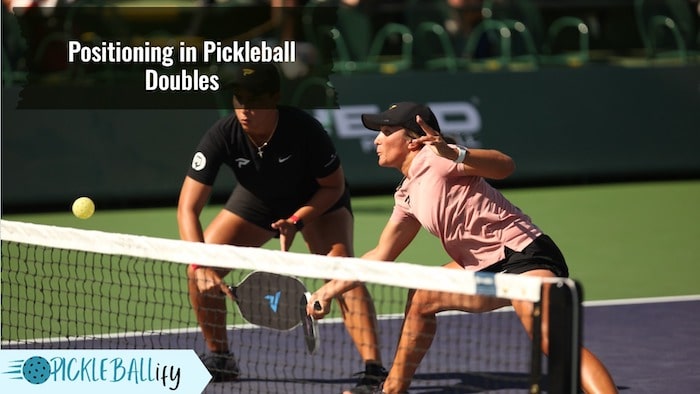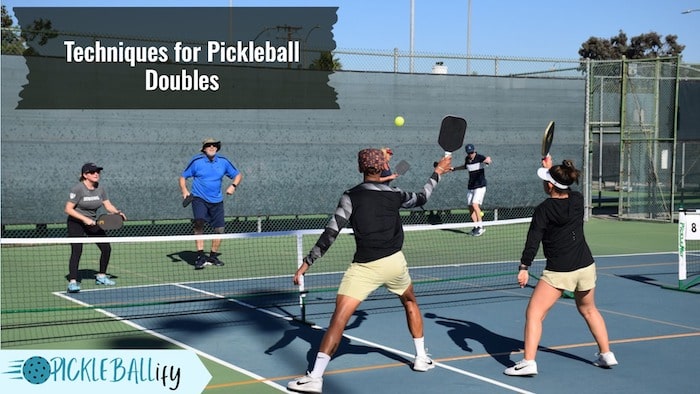Are you looking to up your pickleball game and improve your doubles strategy? Look no further! Pickleball is a fast-paced sport that requires quick thinking, skilled techniques, and strategic positioning. Playing doubles adds an extra layer of complexity to the game, but with the right approach, you can dominate the court.
In this blog post, we’ll dive into everything you need to know about playing pickleball doubles like a pro. From basic fundamentals to advanced strategies, we’ve got you covered. So grab your paddle and let’s get started!
The Basics of Pickleball Doubles
- Pickleball is a fun and exciting sport that can be played by people of all ages. The game is typically played in doubles, where two teams of two players compete against each other on a court divided by a net.
- The objective of the game is to score points by hitting the ball over the net and into the opposing team’s court without them being able to return it successfully. Pickleball doubles follow similar rules as singles but with some differences.

- In pickleball doubles, both teammates play on their respective sides of the court, and they must alternate shots until one team fails to return the ball or hits it out of bounds. Players cannot hit consecutive shots unless their partner has touched the ball first.
- The serve also alternates between teams after every point scored. The server must stand behind the baseline and serve diagonally across his/her opponent’s box while avoiding any foot faults.
- If you are just starting with pickleball doubles, remember that communication between teammates is vital. Calling out who will take which shot can help avoid confusion and missed opportunities for scoring points.
- Now that you have an understanding of what pickleball doubles entails let’s move on to positioning strategies to make sure your gameplay improves!
Positioning in Pickleball Doubles
- Positioning is a crucial aspect of pickleball doubles that can make or break a game. It’s essential to understand where you and your partner should be standing on the court in order to maximize your chances of winning.
- The standard positioning for doubles players is to have one player at the kitchen line and the other player near the baseline. The player at the kitchen line, also known as the net, is responsible for intercepting any shots hit by opponents while their partner covers any shots hit past them towards the back of the court.

- However, there are times when this standard positioning needs to be adjusted depending on various factors such as the opponent’s skills and strategy being used. For example, if one opponent has a strong forehand shot, it may be wise to position yourself closer to their backhand side.
- It’s also important to communicate with your partner about positioning during play. This helps avoid confusion and allows both players to adjust quickly if needed.
- Mastering proper positioning in pickleball doubles takes time but once mastered will help improve your overall gameplay significantly.
Strategy for Pickleball Doubles
Strategy in pickleball doubles is all about positioning, communication, and teamwork. The first strategy to consider is serving placement. Serve deep down the middle or toward the weaker player on your opponent’s side of the court. This can force them to hit a weaker return that you can take advantage of.
Follow the Return-of-Serve to the Non-Volley Line
Pickleball doubles strategy tip #1 is to get to the non-volley line. Because this is so important, make sure you follow every return serve to the non-volley line to increase your chances of winning the rally through this positioning.
Drop Shots are Your Friend
This is one of the most difficult shots to perfect, but if you can do it, it’s a great way to improve your chance of winning at pickleball doubles. Basically, any time you’re not at the non-volley line and your opponent is, this shot will get you to the non-volley line (the kitchen) as well. You’ll be able to flip the odds in your favor.
The drop shot is usually completed by the team who is serving, following the return of serve. This is usually executed on the third shot so it is aptly known as the third drop shot.
Try to Keep Your Opponents at the Baseline
Your opponents should be pinned back if you and your partner are on the non-volley line. You have the advantage here. Your opponents will be able to reach the non-volley line after hitting a shorter shot, which negates your advantage. Instead, hitting shots that keep your competitors pinned in their own court is a better pickleball doubles strategy.
Aim for Their Feet
It is always a good idea to hit the ball at your opponent’s feet, no matter where they are positioned on the court.
It is very difficult to return a ball at the feet without popping it up. You should dink at the feet of your competitors if you are playing with them. You should hit the ball at your opponent’s feet if he or she is in the transition area between the baseline and the non-volley line. Basically, hit the ball at their feet if they are near the baseline. You will certainly become a better doubles pickleball player if you stick to this simple strategy.
“Rather than trying to hit a winner every shot, it is better to place the ball back over the net in control and let the opponents make the fault, or wait for a chance to hit a sure winner.” Stated by USAPickleball.
Add a Little Depth to Your Serve
When serving, the most important thing is to hit it deep – after getting it in, of course. Keep this in mind whenever you serve. Following the return of serve, the return server wants to reach the non-volley line. The serve should be kept deep so that the ball will not be able to reach the line.
Contrary to popular belief, hitting a high-arcing ball deep inside the challenger’s court is better than hitting a serve with the blistering speed that lands several feet inside the baseline.
Step Away from the Baseline When Returning
It is all too common for players to stand at the baseline or even within a foot of the baseline when returning serves.
Stand 2-3 feet behind the baseline when returning a serve unless you know it is likely to be hit short. You will have ample space and time to step in as you return the ball. When the ball is served deep, you won’t be trapped and give up an easy point to your opponent.
Always Return Deep
There are several advantages to a deep return of service. So, when the returner follows the return of serve, they have enough time to move to the non-volley line. Thus, the third shot is longer and harder for the serving team to execute.
Communication When Returning Middle Shots is Key
Shooting down the middle of the court commonly causes confusion and uncertainty about which partner should hit the shot. Decide who will take the middle shots at the beginning of the game as a team.
Possibly, whoever is standing on the forehand side will take the middle shot based on a general rule of thumb. Scream “mine” or “yours” from time to time to communicate if you don’t have a plan of action.
Move as a Cohesive Unit
Playing pickleball doubles is like being tethered to each other by an 8-10 foot rope. You should always be moving together as a pair. Walk back and forth together. Move side to side together. Your opponents will be able to put balls away if you don’t move together as a team.
Patience is a Virtue
Pickleball doubles strategy that requires patience might be the most challenging. Selecting your shots with patience is an important part of patience. Consider a conservative shot if you are unable to hit the ball with a downward blow. In rallies, errors usually prove costly. Being patient can help you avoid mistakes. Don’t rush.
Techniques for Pickleball Doubles
One of the key aspects of playing pickleball doubles is mastering various techniques. Here are some important techniques that will help you improve your game.
- First, the serve is one of the most critical shots in pickleball. A good serve can give you an instant advantage over your opponents. It’s essential to have a consistent and reliable serve that puts your opponents under pressure from the start.
- Another technique to master is volleying. Volleying involves hitting the ball before it bounces on the court. This technique requires quick reflexes and excellent hand-eye coordination.

- Thirdly, dinking is a crucial technique for doubles players as it allows them to control their opponent’s movements with short, soft shots close to the net. Dinking often sets up opportunities for more aggressive shots like smashes or overheads.
- Fourthly, understanding how to hit basic groundstrokes (forehand and backhand) consistently can significantly enhance your performance on both ends of the court.
- Additionally, footwork plays an integral role in executing all these techniques efficiently while maintaining balance and stability throughout every shot.
- And the last, mastering these basic techniques can take time but practice regularly with a partner or coach will undoubtedly yield results in improving your overall performance on-court!
FAQs
No, you cannot. This is known as a “volley” and hitting the ball while standing inside the non-volley zone is considered a fault. The non-volley zone, also known as the “kitchen”, is a 7-foot area on each side of the net where players are not allowed to volley the ball. The purpose of this rule is to prevent players from standing too close to the net and dominating play with quick volleys.
If your serve hits the net but lands inbound on your opponent’s side, it’s called a “let serve”. You get to serve again without penalty. Let serves are common in pickleball and are not considered a fault or a point for either team. This allows players to keep the game moving without having to stop for every serve that hits the net.
Yes, you can switch sides with your partner at any time as long as you’re not delaying or disrupting play. This is a common strategy in pickleball doubles and can be done to take advantage of wind conditions, sun angles, or to give one player a break if they are struggling with their positioning or footwork.
Many players find that serving underhand allows for more control and accuracy. However, some also prefer to use an overhand serve for added speed and power. The underhand serve is a common technique in pickleball and is often used to start the game or to initiate a rally. It involves swinging your paddle under the ball and lifting it over the net with a gentle arc. The overhand serve, on the other hand, is a more powerful technique that involves striking the ball with a swinging motion, similar to a tennis serve.
In pickleball doubles, it’s important to communicate with your partner to determine who takes each shot. Usually, the player with the best position and reach will take the shot, but it’s also important to consider your partner’s strengths and adjust accordingly. Ongoing communication is crucial to ensure good teamwork and coverage of the court.
Conclusion
Pickleball doubles can be a great way to socialize while also getting some exercise. To play it well, you need to understand the basics of positioning and strategy, as well as the techniques needed to execute those strategies. But with practice, anyone can become skilled in this fun sport.
Remember that communication is key when playing pickleball doubles. Always talk with your partner about where they’re going and where they want you to go on the court. And don’t forget to have fun! The more relaxed you are on the court, the better you’ll play.
With these tips and tricks in mind, you should now feel confident about how to play pickleball doubles like a pro! So grab your racket and head out onto the court – it’s time for some competitive (yet friendly) action!

